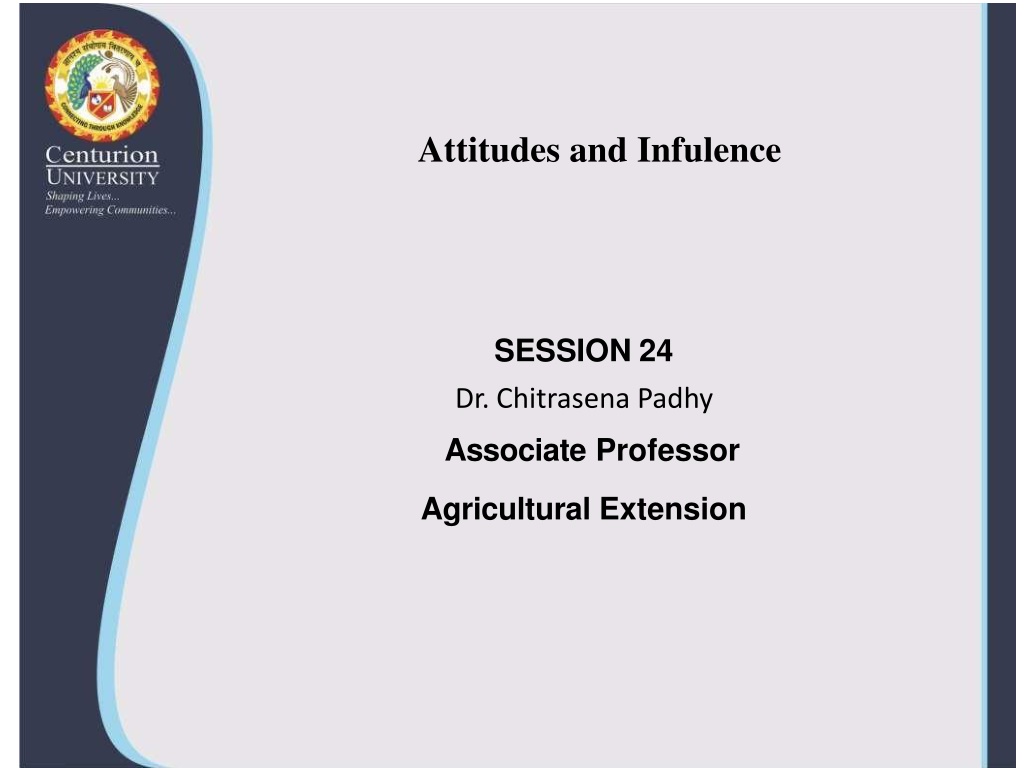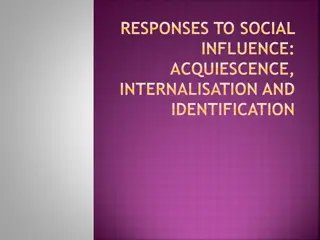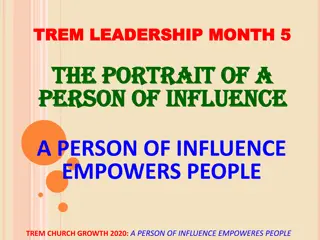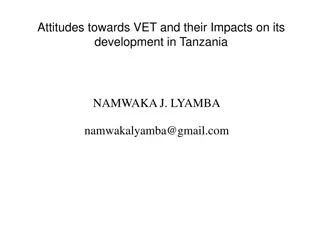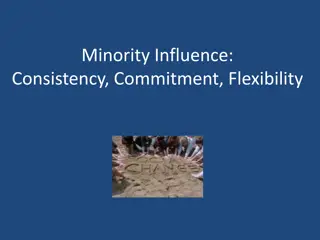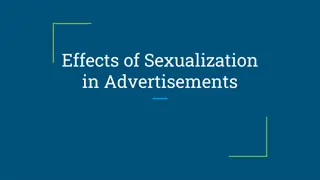Understanding Attitudes and Influence in Behavior Formation
Attitudes are influenced by various factors such as experience, social roles, conditioning, and observation. They can be learned through classical and operant conditioning and by observing others. However, attitudes do not always align with behavior. Factors influencing attitude strength include expertise, personal experience, potential outcomes, and expression frequency.
Download Presentation

Please find below an Image/Link to download the presentation.
The content on the website is provided AS IS for your information and personal use only. It may not be sold, licensed, or shared on other websites without obtaining consent from the author. Download presentation by click this link. If you encounter any issues during the download, it is possible that the publisher has removed the file from their server.
E N D
Presentation Transcript
Attitudes and Infulence SESSION 24 Dr. Chitrasena Padhy Associate Professor Agricultural Extension
Attitude Formation Several factors can influence how and why attitudes form, including: Experience Attitudes form directly as a result of experience. They may emerge due to direct personal experience, or they may result from observation. Social Factors Social roles and social norms can have a strong influence on attitudes. Social roles relate to how people are expected to behave in a particular role or context. Social norms involve society's rules for what behaviors are considered appropriate.
Learning Attitudes can be learned in a variety of ways. Consider how advertisers use classical conditioning to influence your attitude toward a particular product. In a television commercial, you see young, beautiful people having fun on a tropical beach while enjoying a sports drink. This attractive and appealing imagery causes you to develop a positive association with this particular beverage.
Conditioning Operant conditioning can also be used to influence how attitudes develop. Imagine a young man who has just started smoking. Whenever he lights up a cigarette, people complain, chastise him, and ask him to leave their vicinity. This negative feedback from those around him eventually causes him to develop an unfavorable opinion of smoking and he decides to give up the habit.
Observation Finally, people also learn attitudes by observing people around them. When someone you admire greatly espouses a particular attitude, you are more likely to develop the same beliefs. For example, children spend a great deal of time observing the attitudes of their parents and usually begin to demonstrate similar outlooks.
Attitudes can form through direct experience, social influence, formal education, conditioning processes, and observation. Attitudes and Behavior We tend to assume that people behave according to their attitudes. However, social psychologists have found that attitudes and actual behavior are not always perfectly aligned.
After all, plenty of people support a particular candidate or political party yet fail to vote. People also are more likely to behave according to their attitudes under certain conditions. Factors Influencing Attitude Strength Are an expert on the subject Expect a favorable outcome Experience something personally Stand to win or lose something due to the issue Are repeatedly expressed attitudes
Changing to Match Behavior In some cases, people may alter their attitudes to better align them with their behavior. Cognitive dissonance is a phenomenon in which a person experiences psychological distress due to conflicting thoughts or beliefs. In order to reduce this tension, people may change their attitudes to reflect their other beliefs or actual behaviors.
What Is Cognitive Dissonance? Using Cognitive Dissonance Imagine the following situation: You've always placed a high value on financial security, but you start dating someone very financially unstable. You have two options to reduce the tension caused by conflicting beliefs and behavior. You can end the relationship and seek a more financially secure partner, or you can de-emphasize the importance of fiscal stability. In order to minimize the cognitive dissonance between your conflicting attitude and behavior, you either have to change the attitude or change your actions.
Why Attitudes Change? While attitudes can have a powerful effect on behavior, they are not set in stone. The same influences that lead to attitude formation can also create attitude change. Learning Theory Classical conditioning, operant conditioning, and observational learning can be used to bring about attitude change. Classical conditioning can be used to create positive emotional reactions to an object, person, or event by associating positive feelings with the target object.
Operant conditioning can be used to strengthen desirable attitudes and weaken undesirable ones. People can also change their attitudes after observing the behavior of others. Elaboration Likelihood Theory This theory of persuasion suggests that people can alter their attitudes in two ways. First, they can be motivated to listen and think about the message, thus leading to an attitude shift.
Or, they might be influenced by the characteristics of the speaker, leading to a temporary or surface shift in attitude. Messages that are thought-provoking and that appeal to logic are more likely to lead to permanent changes in attitudes. Dissonance Theory As mentioned earlier, people can also change their attitudes when they have conflicting beliefs about a topic. In order to reduce the tension created by these incompatible beliefs, people often shift their attitudes.
Attitudes are not set in stone and may change when people learn new information, when they are persuaded by influential people, or when they experience discomfort due to holding conflicting beliefs. A Word From Verywell Attitudes play a pivotal role in shaping human behavior, from the choices people make about living their lives to the health behaviors they engage in daily.
Understanding where these attitudes come from and how they sometimes change can help you look for ways to improve your attitudes, whether it means adopting a more positive outlook on life or changing your opinion based on new information. FREQUENTLY ASKED QUESTIONS 1.What are the four types of attitude? Attitudes can be positive or negative, and explicit or implicit. Positive attitudes involves good feelings, where negative attitudes are charaterized by hostility, anger, or dislike. Explicit attitudes are conscious, while implicit attitudes are unconscious.
2. What are cognitive and affective components of attitude? The cognitive component of attitude involves the thoughts that people have about something. The affective component refers to the emotional response tht people have about the attitudinal object.
